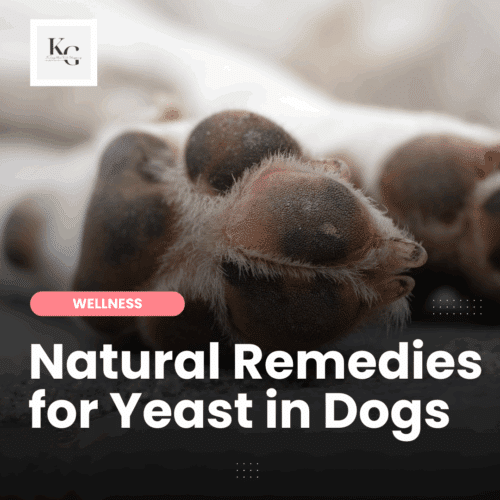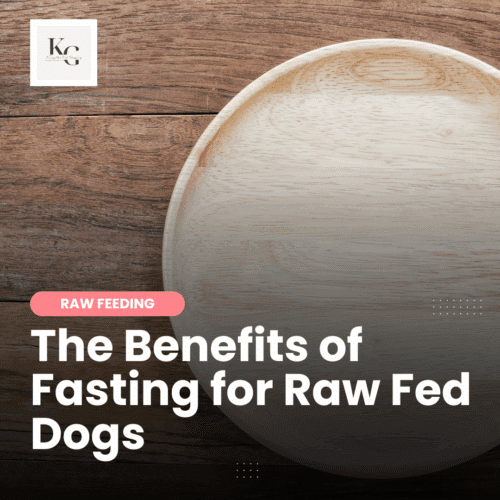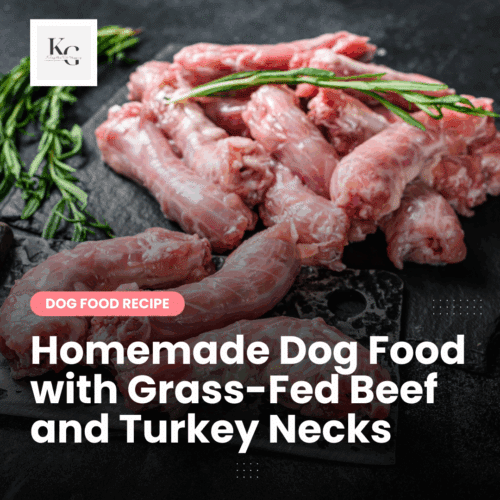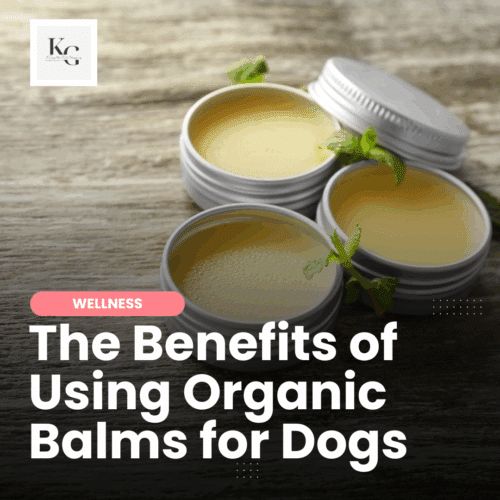Keep the Tail Wagging is supported by pet parents. I occasionally earn a commission (at no additional cost to you) when you click through an affiliate link to one of my favorite products. Thank you for your support. Read More
The myth that garlic is toxic to dogs has persisted despite the abundance of information highlighting its benefits. Garlic has long been praised in natural health circles for its medicinal properties in humans, and when used correctly, it can offer incredible benefits for dogs. Though often misunderstood and mistakenly lumped in with onions, which are toxic, garlic, when fed in proper amounts, can support your dog's immune system, repel pests, and contribute to overall vitality.
Where the Myth Began…
1. Lee et al. (2000), “Hematologic Changes Associated with the Appearance of Heinz Bodies in Dogs Fed Garlic”
- Summary: This is the most widely cited study regarding garlic toxicity in dogs. Researchers fed garlic extract to dogs at high doses—up to 5 grams of garlic per kilogram of body weight per day (equivalent to approximately 20 cloves daily for a medium-sized dog).
- Findings: The dogs developed oxidative damage to red blood cells and Heinz body formation, but none of the dogs developed hemolytic anemia or clinical illness.
- Conclusion: Garlic can cause changes to red blood cells at very high doses, but it does not result in toxicity at typical culinary or supplement levels.
- Why it matters: This study is often misunderstood. The doses used were significantly higher than those that would be administered in a real-life setting, and no dogs became ill.
A 2018 study found that aged garlic extract didn’t have any adverse effects in dogs.
How I Discovered That Garlic Toxicity Was a Myth…
Dr. Richard Pitcairn, DVM – Dr. Pitcairn's Complete Guide to Natural Health for Dogs & Cats
- Summary: Dr. Pitcairn, a pioneer in veterinary homeopathy and holistic medicine, also recommends raw, organic garlic in small amounts for dogs.
- Findings: He reports using garlic for immune support and parasite control with no adverse effects in his decades of clinical practice.
- Conclusion: When fed according to weight and under the guidance of a professional, garlic is safe and beneficial.
What Makes Garlic Beneficial for Dogs?
Garlic (Allium sativum) contains allicin, a sulfur compound that gives garlic its distinctive smell and therapeutic benefits. Allicin is known for its antibacterial, antifungal, antiviral, and antiparasitic properties. In dogs, garlic can:
- Repel fleas, ticks, and mosquitoes naturally
- Support immune function by stimulating the activity of immune cells
- Improve cardiovascular health
- Detoxify the liver by boosting enzyme production
- Fight infections with its natural antibiotic properties
- Aid digestion and support gut health
Garlic also has Anti-Cancer Benefits
The main compound in garlic, allicin, along with other compounds (like diallyl sulfide, diallyl disulfide, and S-allylcysteine), has been shown to:
- Induce apoptosis (programmed cancer cell death)
- Slow tumor growth
- Inhibit angiogenesis (the formation of new blood vessels that feed tumors)
- Reduce inflammation—a key driver in cancer development
These compounds support the body's natural defenses by boosting detoxification enzymes and antioxidant activity.
Key Studies Supporting Garlic's Anti-Cancer Role
- National Cancer Institute (NCI) – Human Cancer Research
- Recognizes garlic as one of the top cancer-fighting foods.
- Reports indicate that individuals (humans) who regularly consume garlic have a reduced risk of developing stomach, colon, and esophageal cancers.
- American Institute for Cancer Research (AICR)
- Highlights garlic for its ability to protect DNA from damage, slow the growth of cancer cells, and reduce inflammation.
- Veterinary Observations
- Holistic veterinarians often include garlic in cancer support diets for dogs, using it to help:
- Boost the immune system
- Control chronic inflammation
- Support detoxification during chemo or other treatments
- Holistic veterinarians often include garlic in cancer support diets for dogs, using it to help:
Read more…
- Autophagy Therapeutic Potential of Garlic in Human Cancer Therapy
- A novel therapeutic anticancer property of raw garlic extract via injection but not ingestion
- 7 Raw Garlic Benefits for Fighting Disease, Dr. Axe
- Allicin: The Beneficial Compound that Makes Garlic So Healthy
- 11 Proven Health Benefits of Garlic
Garlic as a Pest Repellent
One of the most popular uses of garlic in the natural dog care world is as a bug repellent. The scent of garlic, which is metabolized through the dog’s skin and coat, helps make them less appealing to pests, such as fleas, ticks, and mosquitoes. Unlike topical sprays or chemical preventatives, garlic works systemically and is safe for long-term use when appropriately dosed.
How Much Garlic Can Dogs Safely Eat?
When it comes to garlic, dosage is everything. Too much garlic can lead to hemolytic anemia, especially in sensitive breeds or small dogs. The following are general safe daily garlic guidelines, based on a fresh, raw clove:
| Dog's Weight | Garlic Amount |
|---|---|
| 5–10 lbs | 1/6 clove |
| 10–15 lbs | 1/4 clove |
| 20–40 lbs | 1/2 clove |
| 45–70 lbs | 3/4 clove |
| 75–90 lbs | 1 clove |
| 100+ lbs | 1–1.5 cloves |
How to prepare the garlic: Always finely chop and let garlic sit for 10-15 minutes before feeding to activate allicin.
Garlic can be fed daily for up to two weeks, followed by a one-week break. This cycling prevents the overaccumulation of sulfur compounds, allowing the body to reset.
Bug Off Garlic by Springtime Supplements
One of the most trusted and convenient ways to feed garlic to your dog is through a high-quality supplement. Bug Off Garlic by Springtime Supplements is a powdered garlic-based supplement designed to help dogs naturally repel fleas, ticks, and mosquitoes. Bug Off garlic granules contain 3 grams or one teaspoon of garlic (allium sativum) in every scoop.
Key Features of Bug Off Garlic:
- Made with human-grade garlic and blended with sulfur-rich nutrients to support skin and coat health
- Contains no fillers, preservatives, or artificial ingredients
- It can also help improve coat condition and odor control
Dosage Recommendation of Bug Off Garlic:
The dosage of Bug Off Garlic is based on the dog’s weight. Springtime recommends starting slowly with small amounts and gradually increasing to the maintenance dose, allowing the body to adjust.
- Good: One scoop (1 teaspoon) per 60 lb body weight daily.
- Better: Two scoops per 60 lb
- Best: Three scoops per 60 lb
I add ½ teaspoon to my dogs’ meals three to four days weekly during the Spring and Summer months. This amount has been adequate with my dogs.
Warnings About Feeding Garlic to Dogs
While garlic can be incredibly beneficial, it is not safe for every dog:
Do NOT feed garlic to:
- Puppies under 6 months of age
- Pregnant or nursing dogs
- Dogs with anemic conditions or blood clotting disorders
- Dogs undergoing surgery or on blood-thinning medications
Garlic affects red blood cell function, which is why it is critical to avoid it in dogs with vulnerable or compromised health.
When Can Dogs Start Eating Garlic?
Dogs can safely begin consuming garlic at 6 months of age, once their red blood cell production is more stable and they are no longer in the rapid development phase.
Organic vs. Non-Organic Garlic: Does It Matter?
Yes, it does. Organic garlic is free of chemical pesticides, herbicides, and synthetic fertilizers, making it a cleaner and more potent option. Non-organic or GMO garlic may contain residual chemicals and often lacks the same nutritional density due to conventional farming practices. If you're going to use garlic medicinally or as a daily supplement, organic is the better and safer choice.
Using Bug Off garlic granules (or tablets) is easier because I only have to add a small amount daily.
Why Pre-Minced Garlic Doesn’t Work
An easier, and sometimes more affordable, option for adding garlic to a dog’s diet is the pre-minced garlic found in the produce section of the grocery store. However, it doesn’t work as a natural flea, tick, and mosquito repellent, because the processing destroys the enzymes needed to produce the flea-repelling compound, or prevents it from forming at all.
Allicin, the key compound in garlic that produces its flea-repellent properties, is either missing or inactive in the pre-minced products. Allicin is highly unstable and breaks down quickly, often within an hour after the garlic is processed. The pre-minced garlic in jars is typically heat-treated with added preservatives to extend its shelf life, preserved in oil, and stored for weeks or months.
Pre-minced garlic is challenging to dose accurately because the amount of garlic in each jar is inconsistent and may be diluted with oils, which adds the risk of over- or underfeeding a dog.
The Energetics of Garlic
In Traditional Chinese Medicine (TCM), all foods and herbs are classified by their energetic temperature: hot, warm, neutral, cool, or cold. This isn't about the actual temperature of the food, but rather how it affects the body’s internal energy (Qi).
“Hot” Foods in TCM:
- Stimulate the body
- Promote yang energy
- Increase circulation, metabolism, and internal heat
- Can dry dampness, dispel cold, and move stagnation
Garlic, as a “hot” food, has a warming and dispersing effect. It supports digestion, boosts immunity, and helps fight pathogens—perfect for combating cold or stagnant conditions.
What This Means for Dogs
Garlic Is Beneficial For Dogs Who Are:
- Cold-natured (seek warmth, shiver easily, have cold ears/nose/paws)
- Lethargic or sluggish
- Fighting infections, parasites, or chronic damp conditions (like yeast overgrowth or persistent digestive issues)
- Suffering from stagnation (e.g., tumors, cysts, swelling)
But Caution Is Needed For Dogs Who Are:
- Naturally “hot” in constitution (pant a lot, seek cool places, red tongue/gums, dry skin)
- Prone to inflammation, heat-related conditions, or excessive energy
- Already eating a diet high in other “hot” foods (like lamb, venison, or strong warming herbs)
In these cases, feeding garlic to a dog may cause overheating in the system, leading to restlessness, skin irritation, or digestive upset. In my experience, dogs with allergies, digestive issues, and senior dogs tend to have an “energetically hot” disposition. I don’t add Bug Off to meals that primarily contain “hot” proteins. I prefer to pair the garlic supplement with neutral and cooling proteins, such as turkey, pork, duck, beef, and rabbit.
On hot summer days, I pay attention to how my dog responds to garlic, adjusting it if it appears to be making them too uncomfortable. And I don’t add garlic to meals for dogs that are fighting off an illness.
My Thoughts on Feeding Garlic to Dogs
When used correctly, garlic can be a potent addition to a dog’s fresh food diet. It not only boosts immunity and repels pests but also supports long-term health. Remember, moderation, appropriate dosage, and suitable age use are essential for safely enjoying its benefits.
If you have concerns about adding garlic to your dog’s diet, OR if your dog has an illness that may preclude this beneficial herb, seek the guidance of a holistic veterinarian before reaching for garlic.







Thanks, Laura
I love your blog but I did want to point out that there is a lot of data regarding garlic induced hemolytic anemia being much more prevalent in Japanese snd Korean breed dogs whose red blood cells include a ‘special phenotype that usually shows no clinical manifestation, but these dogs are more susceptible to onion-induced hemolytic anemia and NPTS than normal dogs when the same doses of onions and NPTS are admitted’. The article I quoted does say a lower dose could be safely administered. We have a rescue from Korea and I’ve been doing a lot of researching giving him garlic. Your blog post was excellent but I felt it needed the additional information on the Japanese and Korean breeds. Keep up the excellent work!
I’ve grown garlic in the past and I planned to add it to my garden this year but now I’m not sure if I’ll have a garden because of my back. #sadface
Growing your own garlic is so easy! And it barely takes up any space. It can go in the ground just a few inches apart and stay all winter then just harvest when the tops start to brow;. You can really tuck a bulb into the ground ANYWHERE. And dont believe the sites that say store bought garlic cannot be used to grow more garlic. I just make sure I buy the heads that still have roots (US produced). The ones with all the roots cut off are the ones imported from China. Aside from planting and harvesting, it takes NO effort at all to grow.
very helpful information for all pets lover. Thanks